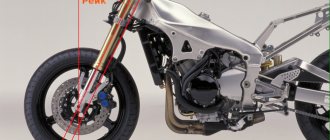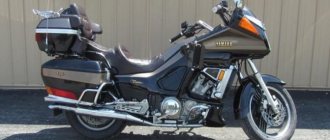You know, I’ve been wanting this motorcycle for a long time. A year ago, when my xjr400 was stolen, I was already thinking about it. The problem was that there was terribly little information on this motorcycle on the Internet. Therefore, I will try to leave this reviewer here with your permission.
I’m not talking about reviews of sellers with dry technical information, but about user reviews. Somewhere there’s a video on YouTube about how to adjust the suspension, somewhere there’s a promo video with a friend lifting this Geon/Shineray onto a rack, here and there epic videos like “first 500 km, review” (generally a mega-useful video about a motorcycle for touring), but I wanted information in the style of “I drove 10,000 km, a wheel fell off.” I’m lying, I wanted the opposite, but the “made in China” stamp, just in case, painted a non-optimistic picture.
I’m not a pro-reviewer, not even a semi-pro, but I hope that my reasoning will help someone with the choice “to take/not to take.” I admit that I have only been the owner of this motorcycle for 3000 km, but I had plenty of opportunity to keep an eye on it, because its first owner is my teammate and, more than once, a ride-along rider nearby.
A year ago we received it from the factory, unpacked it and put it together.
Let's warm up with dry technical information:
Engine capacity: 399cc Dry weight: 150 kg (old version with a plastic tank. Mine according to PTS weighs 162) Wheelbase: 1450 mm Power: 30 hp at 7000 rpm Torque: 32 Nm at 5500 rpm Tank volume: 18 liters for plastic (for some reason 16 for metal) Tires: front 90/90-21 rear 130/80-18 Maximum speed: 140 km/h
Let me make a reservation right away that these figures are for the carburetor version released for the domestic market. In Eastern Europe there is an injection version and I’m quietly thinking about how to install an injector for myself, while slightly violating the Chinese rules, otherwise here they simply won’t extend the motorcycle for a year for the slightest changes...
So, why exactly this Geon/Shineray: 1) midwestern China, the foothills of Tibet, chronic small and large earthquakes, landslides and similar crap, so sports tours or classics may simply not pass. With your permission, I’ll call it turanda, but turanda is the best option. 2) wild prices for imports, so you don’t really want to buy it. 3) older imports simply don’t work, 13-year-old equipment must be disposed of... and so would old Africa... mmm... okay, away with empty thoughts. 4) among the Chinese motorcycle industry in the touring category, this Geon/Shineray is the most powerful. There is another car, the JH600, but I don’t like it because of its weaker suspension and, let’s be honest, just a gloomy appearance...
Now I’ll try to get closer to the actual pros and cons of this unit:
Pros: + Nice easy maneuverability. The Chinese managed to fit in a dry sump engine, the handling of the motorcycle is similar to my Chinese cross-country bike. The center of gravity is low and, despite the height of the motorcycle, it turns wonderfully. Even in traffic jams and jams.
+ Fast Ace suspension - a definite win. I'm afraid to lie, but this is the best that the Chinese put on their motorcycles. The Nastarev fork and rear monoshock provide a lot of possibilities - from the track, to off-road with a load and a passenger, and trying to get out on our enduro-type track-that-we-invented-for-ourselves. I didn’t go far thanks to the dual-sport tires, but I allowed myself to jump a little from mini-jumping boards and go on slides 2-3 meters high and 40 degrees incline upward. On the highway it absorbs bumps just like a charm.
+ decent ground clearance
+ motorcycle size. The domestic market ketais always seemed small to me. Well, it so happened that the average height and size of a local rider is inferior to me, although I am far from gigantic in size. The motorcycle does not seem like a toy scooter. The seat height is impressive for a Chinese 890mm!!! My height is 180, my weight is 80. This is also a slight disadvantage for smaller riders. My wife held the motorcycle only because I managed to grab it - her 163cm and 50kg weight is not enough to hold the motorcycle on both toes. While it may be able to pass in the city, in off-road conditions, where you have to secure the motorcycle with your feet, there is literally no way for it at all.
+ tank consumption of 16 liters in mixed mode, half city-highway - about 350 km. Naturally, if you don’t burn rubber at every traffic light.
+ not bad (but not ideal stock tires). The front roller was replaced after 15,000. The rear one is still holding up. I think I’ll replace it before winter, when I reach 20,000 km. The grip is good both in rain and sun, but in the mud, predictably, I would like the tires to be a little tougher. The photo shows the rear roller after 16,000 km
+ pleasant ductility of the engine (for a Chinese). Loaded with a passenger, I had a great time riding these shameful 30 horses at traffic lights so as not to ride in the traffic. And it was just as good at making its way through roads without asphalt.
+ general wear and tear. Knowing Chinese technology firsthand, I am really amazed by the external condition of this motorcycle. Although it fell and spent the whole working day in the parking lot in the rain, the units look, if not like new, then at least not the way I’m used to seeing other Chinese units with similar mileage. The only let down was the exhaust pipe, which was clearly not of the highest quality metal.
Now about the minuses, where would we be without them: - just a trashy stock chain. The previous owner changed the chain 2000 km before selling the motorcycle to me and replaced it with the same one as stock. In 500 km I pulled it up twice. The issue was resolved by purchasing the Regina chain, the issue of the chain disappeared. 2500 km without braces.
— the stock light is as dull as the stock circuit, despite the fact that there are two lamps. You can't see a thing. The issue was almost resolved by purchasing LED lamps. Still, I'm thinking about buying additional flashlights. Honestly, it's not enough. I won’t drive with this light on a dark night road at 80 km/h. In the city it was all right, but outside the city... Plus, no matter how I tried to adjust it, Uncle Liao, who designed this motorcycle, clearly set the high beam to blind crows. It hits sooooo high. Friends have told me that my neighbor seems far away when I drive towards them.
- incomprehensible Chinese quality. There are 4 such motorcycles in the team and so far the ratio of epic wins to epic failures is 3:1. But 75% is not so much compared to the Japanese or Germans, where factory defects are considered a rare exception to the rule. One local colleague replaced a cracked pendulum twice in a year and a rear monoshock absorber once. Frankly, knowing this comrade, I am not surprised - on the last motorcycle the frame cracked. But it still made me think. Mine... distracted, knocking on wood... so far behaving normally.
- seat. I don’t have much experience with long-distance motorcycles suitable for this, but the bike is a little narrow and a little harsh. We plan to entrust my wife, as a person who has better knowledge of applied tools than me, with the installation of new silicone inserts. The last race of 270 km in a day (considering the slow road along a mountain serpentine road of 40-50 km/h and light stops for a smoke break) made my butt think. No, not everything is so fatal, on the same xjr400 I would curse this road, but still I expected something more serious
- FUCKING NEUTRAL!!! And this is a common problem among our four motorcycles. It is IMPOSSIBLE to catch neutral while standing in first!!! I have already accustomed myself when braking at a traffic light: 4,3,2,1,2, a slight click down. There is no way to click up on the first one. If you blow on the paw, it’s already the second one. I'm used to it - yes. It still infuriates me - yes.
- front brake. If during everyday driving without a load it is enough, then with a passenger and panniers the brake becomes frankly weak. After the same trips on the xjr400, it feels like it’s almost gone. To be honest, the Chinese cross-country racer on checkers brakes not much worse, although the brakes there are also the same as Chinese.
- naturally, 400 Chinese cubes are not 400 Japanese ones. Feels like a sticky 250. The maximum speed that we managed to develop with a passenger and panniers is 125. I understand that the aerodynamics spoiled by the panniers also have an effect, but for our tourists, who are 125 on the highway, this is “Am I a sucker?” a motorcycle is clearly not suitable. Up to 100 it takes off briskly, but beyond that, not so much.
Conclusions: Am I satisfied? Undoubtedly. This is the first Chinese person in my memory who, after getting to know him more closely, began to inspire a certain amount of trust. Not absolute, but nonetheless. For the purposes of leisurely motorcycle touring with occasional trips off the road, the motorcycle is perfect. The Chinese have finally learned how to tighten nuts properly. The previous owner dropped the motorcycle epically on his longest trip. The motorcycle simply turned over and became upside down. I have no idea how this happened. The only damage was a broken windshield. No other problems were noticed, so the owner, having removed the stubs of the windshield, finished the long drive and drove another 4,500 km without intervention, safely returning home along the following route:
Well, a few photos from the previous owner for objectivity, so that there would be no comments like “after 17,000 km it’s normal only because we rode in a supermarket parking lot”
Thanks to those who read. Hope it helps 
Peugeot Geopolis 250
It is unknown what vicissitudes of fate at one time forced the automobile industry to stop supplying Peugeot scooters and motorcycles to Ukraine, but the main thing is that now all this is in the past.
After a long break, a new official importer of this motorcycle has appeared in Ukraine. Having received an invitation from her to try French two-wheeled “delicacies,” we didn’t have to wait long and went to the salon to choose a candidate for our test drive. After examining numerous candidates, my gaze lingered on the Peugeot Geopolis 250. Why it interested me so much, I still don’t understand. Perhaps, of the many 250s that often qualify as a “sofa on wheels,” this one stood out for its small dimensions, high seating position and unusual design with a hint of sporty style. In addition, the Geopolis is equipped with the well-known Piaggio Master 250 engine and large 16-inch wheels. The picture began to become clearer. Such a scooter cannot be called a “sofa”; rather, it is a typical European urban “slick dude”. Whether this is true or not, I had to find out.
First of all, I decided on a testing methodology for myself. The scooter was destined to undergo a severe test of Kyiv's "leaky" asphalt, the "smooth" paving stones of Andreevsky Descent, morning traffic jams and, finally, smooth and car-free roads. It is these “four elements” that are the most frequent habitats of the Peugeot Geopolis.
Without thinking twice, he rushed into battle. The first thing I noticed was the sharp response of the engine to the throttle and... the lack of a clutch (just a few minutes ago I was driving a motorcycle). While my brain switched to “different” control, some time passed, during which the scooter declared itself as a nimble and playful device. Only at first it was greatly hindered by its over-controllability, which manifested itself in a sharp change in the trajectory of movement at the slightest turn of the steering wheel. After the “thoughtful” handling of the motorcycle, such a contrast caused me a slight feeling of confusion: why does such a large scooter need such clear steering? Maybe it was intended not as a city vehicle, but as a sports vehicle? In fact, I didn't even know how close I was to the truth. Indeed, in the Peugeot scooter lineup there is also a Geopolis RS model, painted in bright aggressive colors and equipped with a low windshield. It’s just a pity that it is not yet imported to Ukraine. All this super-controllability would look quite appropriate in it.
As for the standard model, due to its elegant appearance, one gets the impression that it should drive just as calmly and measuredly. But no matter what is done, everything is for the better, and you can find its advantages in everything. So it is in our case. With a slight movement of the steering wheel, you can quickly change lanes or go around a suddenly stopped car. On any other “sofa” such a maneuver would require much more effort. You can just as easily pass through rows of cars without fear that at some point you won’t be able to get around the protruding rearview mirror. On Geopolis you don’t even have to think about how to turn the steering wheel to do this. You just need to do this, and the scooter will instantly follow the driver’s instructions.
And, since I touched on the issue of overcoming traffic jams, I will dwell on it in more detail. Although the scooter looks large, and the engine capacity is almost 250 cm3, on the road it looks like something between a “fifty dollar” and a full-fledged motorcycle. Therefore, maneuvering between cars on it, taking into account its amazing handling, is not difficult. In addition, the height of its steering wheel is such that the handles are above the level of the mirrors of most passenger cars, but lower than those of jeeps. The width of the steering wheel is a little more than 60 centimeters. When I was in Italy or France, I saw more than once a picture of similar scooters rushing between rows of cars, almost without slowing down, and without fear of hitting someone.
Our scooter riders would have a lot to learn from them if... our motorists behaved politely towards two-wheelers and drove strictly in the center of the lane, and before changing lanes they showed warning signals in advance and looked in the mirrors. And while the driving culture in Ukraine is low, we, two-wheelers, have no choice but to slowly make our way between the rows of cars, while not forgetting to use such passive safety features as high beams and a horn signal on during the daytime. This is the only way to attract the attention of motorists (although not all). Fortunately, the head optics on the Peugeot Geopolis are designed competently, and, I would even say, progressively. In low beam mode, only one of the two bright lens headlights works, and when the high beam is turned on, the second headlight joins it. This scheme allows you to clearly identify yourself on the road during the day, and in the dark, when you turn on the high beams, it significantly increases the area of the illuminated surface.
The sound signal for turning on the turn signals deserves special praise in the scooter. Unlike the usual scheme, in which only quiet clicks of the relay and a light indicator on the dashboard remind you of the turned on turn signal, on the Peugeot Geopolis the activation of turn signals or emergency lights is accompanied by pleasant sound signals, coming, as it seemed to me, from a small speaker built somewhere under tidy. They can be heard even with a tightly closed helmet at speeds of up to 60 km/h. With such a “reminder” it is simply impossible to forget to turn off the turn signal after completing the maneuver.
After the test of traffic jams came the test of our roads. Having chosen a small area full of potholes of various sizes, I drove along it several times at different speeds, assessing the performance of the suspensions in a given situation. As it turned out, before the pits it is better to either reduce the speed to a minimum or drive through them at full throttle. The Peugeot Geopolis is clearly not designed for such road conditions - there is a suitable enduro for them in the company’s model range, and on this scooter it is better to avoid our “off-road” conditions. Although its wheels are large, the front fork and a pair of rear shock absorbers are able to smoothly handle only small bumps, but on all other surfaces the scooter shakes quite a bit. But here I would sing a laudatory ode to the rigid frame and build quality of the scooter, since even with considerable shaking I did not hear a single squeak or squeak of plastic joints, as well as the ringing or knocking of dangling parts and wires.
After such a brutal ordeal, I gave the scooter a break and gave myself the opportunity to take a closer look at all its details. First of all, a few words about the immobilizer. The chip with the electronic code is located in the key and can be easily removed from there. But, if the chip is not in close proximity to the ignition switch (at a distance of up to one meter), it is impossible to start the scooter. Thus, you can further protect yourself from scooter theft by sewing a chip, for example, into the lining of your motorcycle jacket. And if someone illegally takes possession of the key to the scooter, he will not be able to start it without your help.
The Peugeot Geopolis has a small, key-locked glove compartment for gloves and other small items, which houses a 12-volt socket. For scooters of this class, this option is rather an exception to the rule, but a pleasant one. Indeed, for those drivers who are often on the road, it is important to be able to quickly recharge the same mobile phone, PDA or GPS navigator, literally without getting off the scooter. Under the seat there is a spacious trunk that can accommodate two “half-face” helmets, but, alas, there is no room for one “integral”. The passenger on this scooter will feel no less comfortable than the driver - large sliding footrests and handles are provided for him, which smoothly turn into a platform for attaching the case. The driver and passenger seats are separated by a step, which also serves as a mini-backrest for the driver's seat. The scooter is easy to park - it has both central and side steps. The latter, by the way, is very convenient to use as an ignition breaker if, for some reason, you are too lazy to reach for the ignition switch, because the scooter did not have a breaker on the right handlebar handle. The Peugeot Geopolis can be placed on the center stand just as easily as on the side stand - a long lever will allow any representative of the fairer sex capable of driving this scooter to perform this simple operation. Why did I put it that way? Yes, because due to design features, it will be very difficult for girls, as well as guys whose height is less than 170 cm, to touch the ground with their feet while sitting on the Geopolis seat. The ideal height of the driver of this scooter, according to its designers, is 175 cm and above.










